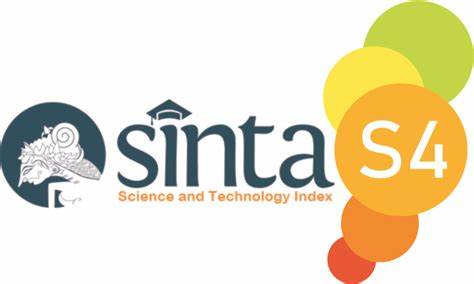Identifikasi Miskonsepsi Menggunakan Three-Tier Diagnostic Test Berbasis Google Form pada Pokok Bahasan Potensial Listrik
Abstract
The purpose of this study was to identify misconceptions by using the Google Form-based Three-Tier Diagnostic Test on a potential electrical subject. The type of misconception in question is conceptual misunderstandings or wrong conceptual understanding. This research uses descriptive research with a quantitative approach. This research was conducted in the Computer System Engineering Program of Bina Insan Lubuklinggau University. Data collection techniques using multilevel multiple-choice diagnostic tests, the reason for choosing answers in the form of essays or explaining concepts on the selected answers are then uploaded in jpg or pdf form and lastly the confidence level or Certainty of Response Index (CRI). Data analysis is done by looking for the percentage of misconceptions of each indicator. The results of the study obtained misconception data with an average percentage of 34% and were in the category of moderate misconceptions. The value of students who understand the concept but are not sure is 1% and the average value of students who do not understand the concept is 4%. Overall, the average value of students who understand the concept is greater than in other categories of 61%.
References
Ariani, T. (2019). Perbedaan Hasil Belajar Fisika Menggunakan Model Pembelajaran Student Team Achievement Division (STAD) dan Model Pembelajaran Teams Games Tournament (TGT) Di SMP Negeri Air Lesing. Jurnal Sains dan Pendidikan Fisika, 14(2).
Astuti, B., Fitrianingrum, A. M., & Sarwi, S. (2018). Penerapan Instrumen Three-Tier Test untuk Mengidentifikasi Miskonsepsi Siswa SMA pada Materi Keseimbangan Benda Tagar. Phenomenon: Jurnal Pendidikan MIPA, 7(2), 88-98.
Hasanah, Avisa. 2020. Pengembangan Instrumen Miskonsepsi Berbasis Google Forms Pada Materi Usaha dan Energi Menggunakan Four Tier Test . Lampung: UIN Raden Intan
Hasan,S.D., Bagayoko., & Kelley, E.L (1999). Misconceptions and the Certainty of Response Index (CRI). Journalof Phys Educ.
Hashish, A. H., Seyd-Darwish, I., & Tit, N. (2020). Addressing Some Physical Misconceptions in Electrostatics of Freshman Engineering Students. International Journal for Innovation Education and Research, 8(2), 01–07
Iqbal. M., Simarmata. J., & Feriyansyah. F. (2018). Using Google form for Student Worksheet as Learning Media. International Journal of Engineering & Technology, 7 (3.4) 321-324
Jumini, Sri, dkk. 2017. Identifikasi Miskonsepsi Fisika Menggunakan Three Tier Diagnostic Test pada Pokok Bahasan Kinematika Gerak. Wonosobo: Universitas Sains Al-Quran
Karim. S., Saepuzaman. D., & Sriyansyah. S.P (2015) Diagnosis Kesulitan Belajar Mahasiswa Dalam Memahami Konsep Momentum. Jurnal penelitian & pengembangan pendidikan fisika. Vol 1 no 1 hal 85
Maryam, E., & Fahrudin, A. (2020). Pengembangan Sound Card Laptop sebagai Alat Praktikum Fisika untuk Penentuan Percepatan Gravitasi Bumi. Silampari Jurnal Pendidikan Ilmu Fisika, 2(1), 29-40.
Mosik & Maulana. P.(2010). Usaha Mengurangi Terjadinya Miskonsepsi Fisika Melalui Pembelajaran Dengan Pendekatan Konflik Kognitif . Jurnal Pendidikan Fisika Indonesia. Vol 6 hal 98-103.
Nurhayati, N., Al Sagaf, S. L. H., & Wahyudi, W. (2020). PENGEMBANGAN TES DIAGNOSTIK THREE-TIER MULTIPLE CHOICE UNTUK MENGUKUR KONSEPSI FISIKA SISWA SMA. JP (Jurnal Pendidikan): Teori dan Praktik, 4(2), 47-54.
Nurulwati., Veloo & Ali. R. M.(2014) Suatu Tinjauan Tentang Jenis-Jenis Dan Penyebab Miskonsepsi Fisika. Jurnal Pendidikan Sains Indonesia, Vol. 02, No.01, hlm 87-95
Rachmawati . Y., Maarif. M., Fadillah. N., Inayah. N., Ummah. K., Siregar. N.M.F., Amalianingsih. R., Aftanalia. F.,
Auliyah.A. (2020) Studi Eksplorasi Pembelajaran Pendidikan IPA Saat Masa Pandemi COVID-19 di UIN Sunan Ampel Surabaya. Indonesian Journal of Science Learning. Vol 1 (1) (2020) 32-36
Suhermiati, I. (2015). Analisis Miskonsepsi Siswa pada Materi Pokok Sintesis Protein Ditinjau dari Hasil Belajar Biologi Siswa. BioEdu, 4(3).
Sulistiyono, S. (2020). EFEKTIVITAS MODEL PEMBELAJARAN INKUIRI TERBIMBING TERHADAP KETERAMPILAN PROSES SAINS DAN PEMAHAMAN KONSEP FISIKA SISWA MA RIYADHUS SOLIHIN. Jurnal Pendidikan Fisika Undiksha, 10(2), 61-73.
Sheftyawan, W. B., Prihandono, T., & Lesmono, A. D. (2018). Identifikasi Miskonsepsi Siswa Menggunakan Four-Tier Diagnostic Testpada Materi Optik Geometri. Jurnal Pembelajaran Fisika, 7(2), 147–153
Taufiq, M. (2012) Remediasi Miskonsepsi Mahasiswa Calon Guru Fisika Pada Konsep Gaya Melalui Penerapan Model Siklus Belajar (Learning Cycle) 5E. Jurnal Pendidikan IPA Indonesia. Vol 1 (2) hAl 198-203
Verkade, H., Mulhern, T. D., Lodge, J., Elliott, K., Cropper, S., Rubinstein, B., . .. Dooley, L. (2017). Misconceptions as a Trigger For Enhancing Student Learning in Higher Education. The University of Melbourne: Melbourne.
Zakiya, Z., Amin, A., & Lovisia, E. (2019). PENERAPAN METODE EKSPERIMEN PADA PEMBELAJARAN FISIKA SISWA KELAS X SMAN 3 LUBUKLINGGAU TAHUN PELAJARAN 2018/2019. SILAMPARI JURNAL PENDIDIKAN ILMU FISIKA, 1(2), 130-138.






.png)







